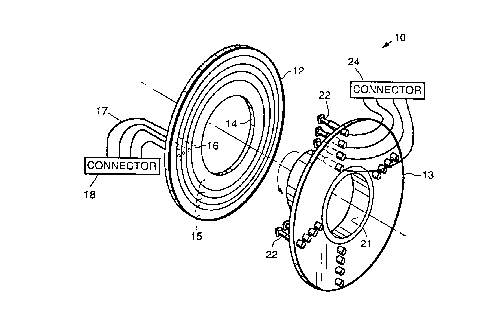Some of the information on this Web page has been provided by external sources. The Government of Canada is not responsible for the accuracy, reliability or currency of the information supplied by external sources. Users wishing to rely upon this information should consult directly with the source of the information. Content provided by external sources is not subject to official languages, privacy and accessibility requirements.
Any discrepancies in the text and image of the Claims and Abstract are due to differing posting times. Text of the Claims and Abstract are posted:
| (12) Patent: | (11) CA 2176047 |
|---|---|
| (54) English Title: | SPRING LOADED ROTARY CONNECTOR |
| (54) French Title: | RACCORD ROTATIF A RESSORT DE RAPPEL |
| Status: | Expired and beyond the Period of Reversal |
| (51) International Patent Classification (IPC): |
|
|---|---|
| (72) Inventors : |
|
| (73) Owners : |
|
| (71) Applicants : |
|
| (74) Agent: | MARKS & CLERK |
| (74) Associate agent: | |
| (45) Issued: | 2000-04-11 |
| (22) Filed Date: | 1996-05-08 |
| (41) Open to Public Inspection: | 1996-11-23 |
| Examination requested: | 1996-05-08 |
| Availability of licence: | N/A |
| Dedicated to the Public: | N/A |
| (25) Language of filing: | English |
| Patent Cooperation Treaty (PCT): | No |
|---|
| (30) Application Priority Data: | ||||||
|---|---|---|---|---|---|---|
|
A rotary connector (10) comprising first and second printed wiring boards (12.
13) that rotate relative to each other and that are electrically interconnected using spring
loaded pogo-stick type contacts (22). The spring loaded contacts are used to transfer
electrical signals or power to metallized rings (15) or contacts formed on the first
printed wiring board (11). The spring-loaded pogo-stick type contacts (22) are very
rugged and provide for a rotary connector (10) having long life.
Note: Claims are shown in the official language in which they were submitted.
Note: Descriptions are shown in the official language in which they were submitted.

2024-08-01:As part of the Next Generation Patents (NGP) transition, the Canadian Patents Database (CPD) now contains a more detailed Event History, which replicates the Event Log of our new back-office solution.
Please note that "Inactive:" events refers to events no longer in use in our new back-office solution.
For a clearer understanding of the status of the application/patent presented on this page, the site Disclaimer , as well as the definitions for Patent , Event History , Maintenance Fee and Payment History should be consulted.
| Description | Date |
|---|---|
| Time Limit for Reversal Expired | 2007-05-08 |
| Letter Sent | 2006-05-08 |
| Inactive: IPC from MCD | 2006-03-12 |
| Inactive: IPC from MCD | 2006-03-12 |
| Grant by Issuance | 2000-04-11 |
| Inactive: Cover page published | 2000-04-10 |
| Pre-grant | 2000-01-17 |
| Inactive: Final fee received | 2000-01-17 |
| Letter Sent | 1999-12-16 |
| Amendment After Allowance Requirements Determined Compliant | 1999-12-16 |
| Inactive: Amendment after Allowance Fee Processed | 1999-11-10 |
| Amendment After Allowance (AAA) Received | 1999-11-10 |
| Notice of Allowance is Issued | 1999-07-26 |
| Letter Sent | 1999-07-26 |
| Notice of Allowance is Issued | 1999-07-26 |
| Inactive: Approved for allowance (AFA) | 1999-06-23 |
| Inactive: Status info is complete as of Log entry date | 1998-04-20 |
| Inactive: Application prosecuted on TS as of Log entry date | 1998-04-20 |
| Application Published (Open to Public Inspection) | 1996-11-23 |
| Request for Examination Requirements Determined Compliant | 1996-05-08 |
| All Requirements for Examination Determined Compliant | 1996-05-08 |
There is no abandonment history.
The last payment was received on 1999-04-29
Note : If the full payment has not been received on or before the date indicated, a further fee may be required which may be one of the following
Patent fees are adjusted on the 1st of January every year. The amounts above are the current amounts if received by December 31 of the current year.
Please refer to the CIPO
Patent Fees
web page to see all current fee amounts.
| Fee Type | Anniversary Year | Due Date | Paid Date |
|---|---|---|---|
| Registration of a document | 1996-05-08 | ||
| Request for examination - standard | 1996-05-08 | ||
| MF (application, 2nd anniv.) - standard | 02 | 1998-05-08 | 1998-04-20 |
| Registration of a document | 1998-09-09 | ||
| MF (application, 3rd anniv.) - standard | 03 | 1999-05-10 | 1999-04-29 |
| 1999-11-10 | |||
| Final fee - standard | 2000-01-17 | ||
| MF (patent, 4th anniv.) - standard | 2000-05-08 | 2000-04-25 | |
| MF (patent, 5th anniv.) - standard | 2001-05-08 | 2001-04-17 | |
| MF (patent, 6th anniv.) - standard | 2002-05-08 | 2002-04-16 | |
| MF (patent, 7th anniv.) - standard | 2003-05-08 | 2003-04-16 | |
| MF (patent, 8th anniv.) - standard | 2004-05-10 | 2004-04-13 | |
| MF (patent, 9th anniv.) - standard | 2005-05-09 | 2005-04-13 |
Note: Records showing the ownership history in alphabetical order.
| Current Owners on Record |
|---|
| HE HOLDINGS, INC. D/B/A HUGHES ELECTRONICS |
| RAYTHEON COMPANY |
| Past Owners on Record |
|---|
| MOHI SOBHANI |